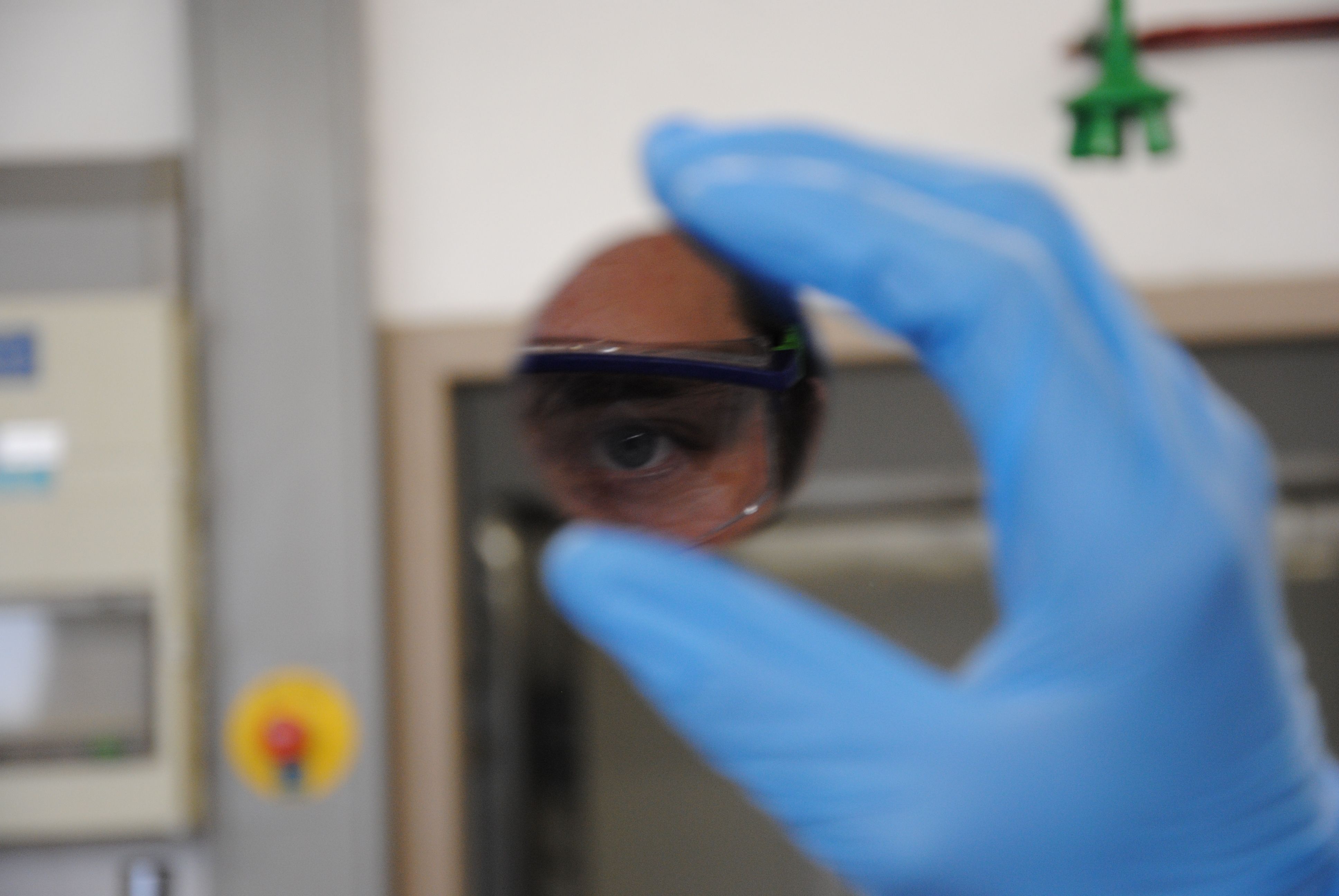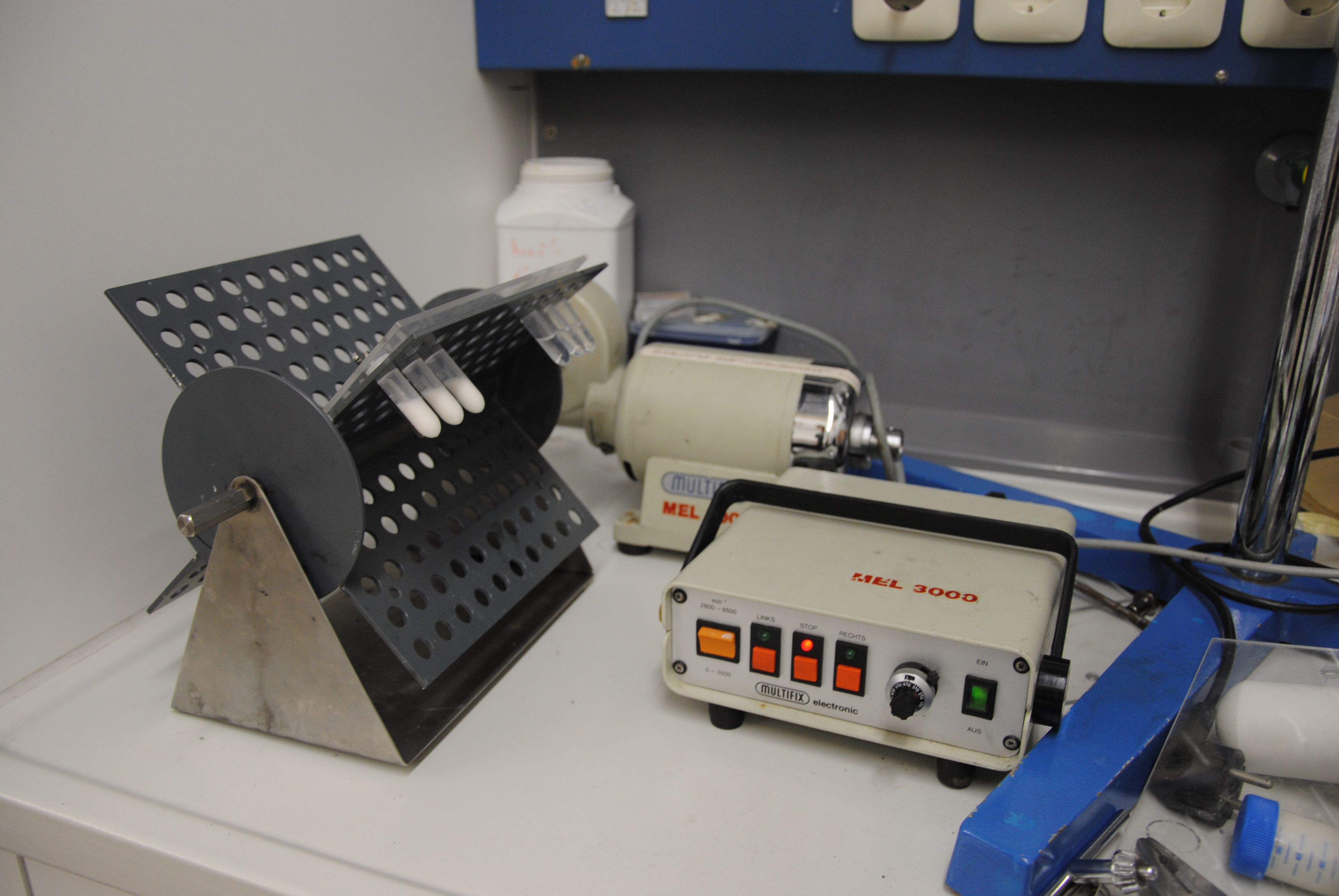Team:Bielefeld-Germany/Results/S-Layer/Guide/7
From 2011.igem.org
m (→Let the immobilization begin) |
|||
| (3 intermediate revisions not shown) | |||
| Line 1: | Line 1: | ||
{{Bielefeld_2011_Header}} | {{Bielefeld_2011_Header}} | ||
| + | <html><img src="https://static.igem.org/mediawiki/2011/2/28/Bielefeld-header-guide.png"/><p></p></html> | ||
__NOTOC__ | __NOTOC__ | ||
| Line 11: | Line 12: | ||
[[Image:IGEM-Bielefeld2011-Silicabeads.JPG|400px|thumb|left|Silicon dioxide beads.]] | [[Image:IGEM-Bielefeld2011-Silicabeads.JPG|400px|thumb|left|Silicon dioxide beads.]] | ||
| - | [[Image:IGEM-Bielefeld2011-Waver.JPG|400px|thumb|left|A silicon | + | [[Image:IGEM-Bielefeld2011-Waver.JPG|400px|thumb|left|A silicon wafer.]] |
<br style="clear: both" /> | <br style="clear: both" /> | ||
| - | S-layers can reassemble on various different surfaces like gold, nylon, functionalized glass or silicon dioxide. We used silicon dioxide because it is low-priced and easy to handle. For microscopy we used silicon | + | S-layers can reassemble on various different surfaces like gold, nylon, functionalized glass or silicon dioxide. We used silicon dioxide because it is low-priced and easy to handle. For microscopy we used silicon wafers with a silicon dioxide surface. Then... |
==Let the immobilization begin== | ==Let the immobilization begin== | ||
| Line 30: | Line 31: | ||
| - | '''Silicon | + | '''Silicon wafers''' |
| - | Silicon | + | Silicon wafers are not that cheap and not that applicable as silica beads but they represent a very plane surface. Using silicon wafers with a silicon dioxide surface: Cut or break the wafer into small pieces, place it in a 1.5 mL reaction tube, add 900 µL HBSS buffer (pH 7.4, for SgsE) or recrystallization solution (pH 9.0, for SbpA), add 100 µL of your monomeric solution and wait for 4 h (room temperature). Rinse the wafer with ddH<sub>2</sub>O and store it in ddH<sub>2</sub>O at 4 °C until use. The methods for recrystallisation were developed at and published by the BoKu Wien ([[Team:Bielefeld-Germany/Results/S-Layer/Guide/7#References |view references]]). |
==References== | ==References== | ||
| Line 49: | Line 50: | ||
<html> | <html> | ||
<div style="text-align:center; width:360px; margin-left:auto; margin-right:auto;"> | <div style="text-align:center; width:360px; margin-left:auto; margin-right:auto;"> | ||
| - | <img id="Image-Maps_4201110282010008" src="https://static.igem.org/mediawiki/2011/ | + | <img id="Image-Maps_4201110282010008" src="https://static.igem.org/mediawiki/2011/e/ea/Bielefeld-Germany-2011-Navigationbar_end.png" usemap="#Image-Maps_4201110282010008" border="0" width="360" height="83" alt="" /> |
<map id="_Image-Maps_4201110282010008" name="Image-Maps_4201110282010008"> | <map id="_Image-Maps_4201110282010008" name="Image-Maps_4201110282010008"> | ||
<area shape="rect" coords="10,10,170,60" href="https://2011.igem.org/wiki/index.php?title=Team:Bielefeld-Germany/Results/S-Layer/Guide/6" alt="Previous page" title="Previous page" /> | <area shape="rect" coords="10,10,170,60" href="https://2011.igem.org/wiki/index.php?title=Team:Bielefeld-Germany/Results/S-Layer/Guide/6" alt="Previous page" title="Previous page" /> | ||
Latest revision as of 02:55, 29 October 2011


Immobilization and recrystallisation of S-layer proteins
You have your S-layer protein monomer solution? Then you are no longer than five hours away from your nanobiotechnological device - and this only because you have to wait 4 hours for the recrystallization and immobilization of your S-layer proteins. But before you begin...
Choose your surface
S-layers can reassemble on various different surfaces like gold, nylon, functionalized glass or silicon dioxide. We used silicon dioxide because it is low-priced and easy to handle. For microscopy we used silicon wafers with a silicon dioxide surface. Then...
Let the immobilization begin
Using silica beads
Weigh in 100 mg silica beads in a 2 mL reaction tube, add 900 µL HBSS buffer (pH 7.4, for SgsE) or recrystallization solution (pH 9.0, for SbpA) and 100 µL of your monomeric solution. You need these buffers because the S-layers we provided only self-assemble in the presence of ions e.g. calcium. Incubate the mix 4 h at room temperature on a vertical rotator. Bring down the beads afterwards by centrifugation, wash them with ddH2O and store them in ddH2O at 4 °C - finished. Now you have silica beads coated with your own functionalized nanobiotechnological surface. This is what we call do it yourself nanobiotechnology. The methods for recrystallisation were developed at and published by the BoKu Wien (view references).
Silicon wafers
Silicon wafers are not that cheap and not that applicable as silica beads but they represent a very plane surface. Using silicon wafers with a silicon dioxide surface: Cut or break the wafer into small pieces, place it in a 1.5 mL reaction tube, add 900 µL HBSS buffer (pH 7.4, for SgsE) or recrystallization solution (pH 9.0, for SbpA), add 100 µL of your monomeric solution and wait for 4 h (room temperature). Rinse the wafer with ddH2O and store it in ddH2O at 4 °C until use. The methods for recrystallisation were developed at and published by the BoKu Wien (view references).
References
Badelt-Lichtblau H, Kainz B, Völlenkle C, Egelseer EM, Sleytr UB, Pum D, Ilk N (2009) Genetic engineering of the S-layer protein SbpA of Lysinibacillus sphaericus CCM 2177 for the generation of functionalized nanoarrays, [http://pubs.acs.org/doi/abs/10.1021/bc800445r Bioconjug Chem. 20(5):895-903].
Kainz B, Steiner K, Möller M, Pum D, Schäffer C, Sleytr UB, Toca-Herrera JL (2010) Absorption, Steady-State Fluorescence, Fluorescence Lifetime, and 2D Self-Assembly Properties of Engineered Fluorescent S-Layer Fusion Proteins of Geobacillus stearothermophilus NRS 2004/3a, [http://pubs.acs.org/doi/abs/10.1021/bm901071b Biomacromolecules 11(1):207-214].
Schäffer C, Novotny R, Küpcü R, Zayni S, Scheberl A, Friedmann J, Sleytr UB, Messner P (2007) Novel Biocatalysts Based on S-Layer Self-Assembly of Geobacillus Stearothermophilus NRS 2004/3a: A Nanobiotechnological Approach, [http://onlinelibrary.wiley.com/doi/10.1002/smll.200700200/pdf Small 3(9):1549-1559].
Tschiggerl H, Breitwieser A, de Roo G, Verwoerd T, Schäffer C, Sleytr U B (2008) Exploitation of the S-layer self-assembly system for site directed immobilization of enzymes demonstrated for an extremophilic laminarinase from Pyrococcus furiosus, [http://www.sciencedirect.com/science/article/pii/S0168165607016070 Journal of Biotechnology 133:403-411].

 "
"





